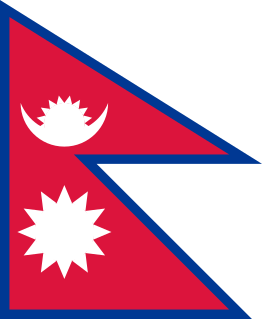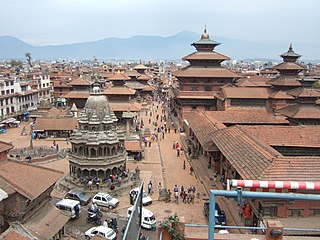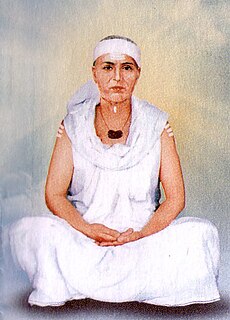
Kathmandu is the capital and largest city of Nepal, with a population of around 1 million. Also known as the city of temples, the city stands at an elevation of approximately 1,400 metres above sea level in the bowl-shaped Kathmandu valley in central Nepal. The valley was historically called the "Nepal Mandala" and has been the home of the Newar people, a cosmopolitan urban civilization in the Himalayan foothills. The city was the royal capital of the Kingdom of Nepal and hosts palaces, mansions and gardens of the Nepalese aristocracy. It has been home to the headquarters of the South Asian Association for Regional Cooperation (SAARC) since 1985. Today, it is the seat of government of the Nepalese republic, established in 2008, and is part of the Bagmati Province.

Nepal, officially the Federal Democratic Republic of Nepal, is a sovereign country in South Asia. It is mainly in the Himalayas, but also includes parts of the Indo-Gangetic Plain. It is the 49th largest country by population and 93rd largest country by area. It is landlocked and borders Tibet in the north and India in the south, east and west, while Bangladesh is located only 27 km (17 mi) from its southeastern tip and Bhutan is separated from it by the Indian state of Sikkim. Nepal has a diverse geography, including fertile plains, subalpine forested hills, and eight of the world's ten tallest mountains, including Mount Everest, the highest point on Earth. Kathmandu is the capital and the largest city. Nepal is a multiethnic country, with Nepali as the official language.

Newar or Newari, known officially in Nepal as Nepal Bhasa, is a Sino-Tibetan language spoken by the Newar people, the indigenous inhabitants of Nepal Mandala, which consists of the Kathmandu Valley and surrounding regions in Nepal.

Lalitpur Metropolitan City, historically Patan, is the third largest city of Nepal after Kathmandu and Pokhara, and it is located in the south-central part of Kathmandu Valley, a new metropolitan city of Nepal. Lalitpur is also known as Manigal. It is best known for its rich cultural heritage, particularly its tradition of arts and crafts. It is city renowned for its festival and feast, fine ancient art, and the making of metallic and stone carved statues. At the time of the 2011 Nepal census it had a population of 226,728 in 54,748 individual households. The city received extensive damage from an earthquake on 25 April 2015.

Hinduism is the main and largest religion of Nepal. The Constitution of Nepal has established a call for the protection of this age-old religion throughout the country. In 2007 the country declares itself that it is a secular country, still some special privileges were also given to Hinduism. According to the 2011 census, the Hindu population in Nepal is estimated to be around 22,493,649 including native Kirat Mundhum, Prakriti and Bon which have deep roots and strong connection with Sanatan Dharma and all together accounts for at least 85% of country's population. The national calendar of Nepal, Vikram Samvat, is a solar Hindu calendar essentially the same to that widespread in North India as a religious calendar, and is based on Hindu units of time. Nepal remained the last Hindu country in the world, till 2007 after the abolition of monarchy in the nation.

Education in Nepal was long based on home-schooling and gurukulas. The first formal school, Durbar High School, established by Jung Bahadur Rana in 1853, was intended for the elite. The birth of Nepalese democracy in 1951 opened its classrooms to a more diverse population. Education in Nepal from the primary school to the university level has been modeled from the very inception on the Indian system, which is in turn the legacy of the old British Raj.
Prostitution in Nepal is illegal. The Human Trafficking and Transportation (Control) Act, 2064, Act Number 5 of the Year 2064 (2008), criminalises prostitution and living of the earnings of prostitution by including it in the definition of human trafficking. UNAIDS estimate there to be 67,300 prostitutes in the country.

Nepal Sambat is the lunar calendar used by the Nepalese-speaking people native to the Indian subcontinent of Nepalese nationality and ethnic Nepalis. The Calendar era began on 20 October 879 AD, with 1141 in Nepal Sambat corresponding to the year 2020–2021 AD. Nepal Sambat appeared on coins, stone and copper plate inscriptions, royal decrees, chronicles, Hindu and Buddhist manuscripts, legal documents and correspondence. Though Nepal Sambat is declared a national calendar and is used widely in Nepal, it is mostly used by the Newar community whereas Bikram Sambat (B.S) remains the dominant calendar throughout the country. All the major festivals are based on Bikram Sambat along with official purposes.

Bhutanese refugees are Lhotshampas ("southerners"), a group of Nepali language-speaking Bhutanese people. These refugees registered in refugee camps in eastern Nepal during the 1990s as Bhutanese citizens deported from Bhutan during the protest against Bhutanese state and monarch by some of the Lhotshampas demanding democracy and different state. As Nepal and Bhutan have yet to implement any agreement on repatriation, many Bhutanese refugees have since resettled to North America, Oceania and Europe under the auspices of the Office of the United Nations High Commissioner for Refugees. Many Lhotshampa also migrated to areas of West Bengal and Assam in India independently of the UNHCR.

Christianity is, according to the 2011 census, the fifth most practiced religion in Nepal, with 375,699 adherents, or 1.4% of the population. However, it is widely claimed that non-Hindus are systematically under-reported in Nepal's censuses, and informed observers have estimated that there are at least 1 million Nepali Christians. According to some Christian groups, there may be as many as 3 million Christians in Nepal, constituting up to 10% of the country's population. A report by Gordon Conwell Theological Seminary identified the Nepali church the fastest growing in the world. The vast majority of Nepali Christians are evangelical Protestants ; there is also a small Catholic population of roughly 10,000.
Child Workers in Nepal (CWIN) is a non-governmental organization (NGO) working as an advocate for children's rights. CWIN supports street children, children subjected to child labour, children who are sexually exploited, and also those victimized by violence. The organization's objective is to protect the rights of children in Nepal. It was established in 1987 by a group of students at Tribhuvan University who, upon investigating the conditions of children living on the streets in Kathmandu, Nepal, recognized the need for advocacy in this area. As a "watchdog" in the field of child rights in Nepal, CWIN acts as a voice for the disadvantaged and exploited children. It does this by lobbying, campaigning, and pressuring the government to protect and promote children's rights, and to end exploitation, abuse and discrimination against children.

Gai Jatra, is a festival celebrated in Nepal, mainly in Kathmandu valley by the Newar community. The festival is generally celebrated in the month of Bhadra (August–September). The date is set according to the lunar Nepa and falls on the first day of the dark four night of the month of Gunla.

Yogmaya Neupane(Nepali: योगमाया न्यौपाने) (1867–1941) was a religious leader, women's rights activist and poet based in Bhojpur district of Nepal. Yogmaya is considered to be among the pioneer female poets in Nepal with her only published book of poems, the Sarwartha Yogbani considered to be her most notable contribution.
The Hyolmo are an indigenous people mainly from the Eastern and Northern Himalayan Regions of Nepal. They refer to themselves as the "hyolmo" or "Yolmopa" and are native residents of the Helambu valleys and the surrounding regions of Northeastern Nepal. Their combined population in these regions is around 11,000. They also have sizeable communities in Bhutan, Darjeeling, Sikkim and some regions of South-Western Tibet. They are among the 59 indigenous groups officially recognized by the Government of Nepal as having a distinct cultural identity and are also listed as one of the 645 Scheduled Tribes of India.
Nepalis in Russia comprises residents from Nepal in Russia, including temporary expatriates and permanent residents, as well as their locally born descendants.
There is a large community of Nepalese people in Malaysia, recruited from Nepal, foreign workers and their families. There are about 700,000 Nepalis currently living in Malaysia.
Nepalis in Qatar are migrants from Nepal to Qatar, mostly migrant workers and permanent residents, as well as their locally born descendants. As of May 2017, 400 thousand Nepali Citizens lived in Qatar as migrant workers, Nepal is second largest expatriate community in Qatar. While there are Nepalese working in the business and administrative sectors of Qatar, most workers from Nepal fall under the umbrella of unskilled labor, and hold jobs in sectors such as construction and landscaping. Many workers from Nepal are hired to work on the construction of stadiums and railways that are being designed for the 2022 FIFA World Cup to be held in Qatar. According to Time Magazine, due to the terrible working conditions in Qatar, a Nepali worker dies every other day.
Korean Nepalese are the Nepalis who form a small expatriate community consisting mainly of Catholic nuns, volunteers and businesspeople. According to South Korea's Ministry of Foreign Affairs and Trade, there were 645 South Koreans living in Nepal as of 2013, up by more than 70% from 374 in 2009. There are also known to be some North Koreans doing business in the country.
Nepalese Muslims are people residing in Nepal who follow the religion of Islam. Their ancestors arrived in Nepal from different parts of South Asia, Central Asia and Tibet during different epochs, and have since lived amidst the numerically dominant Hindus and Buddhists. About 97% of the Muslim community live in the Terai region, while the other 4% are found mainly in the city of Kathmandu and Gorkha and the western hills. The community numbers 971,056, about 5% of the total population of Nepal. Districts with large Muslim population include Sarlahi (9.9%), Rautahat (17.2%), Bara (11.9%), and Parsa (17.3%) in the central Terai region bordering the Indian state of Bihar, Kapilbastu (16.8%) and Banke (16%) in the western Terai and Siraha (7%) and Sunsari (10%) and Saptari (10%) eastern Terai Gorkha (2.8%) hill.
The community of Nepalis in China consists of Nepalese immigrants and expatriates to China as well as Chinese citizens of Nepalese descent.










